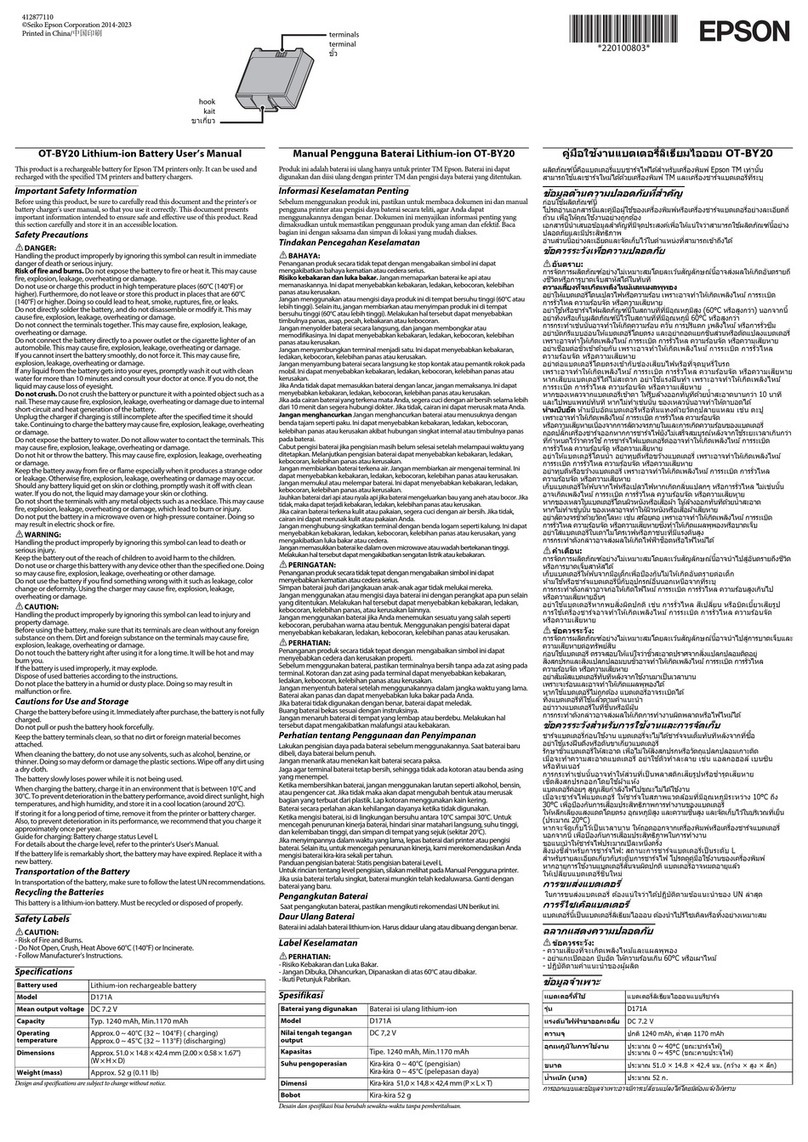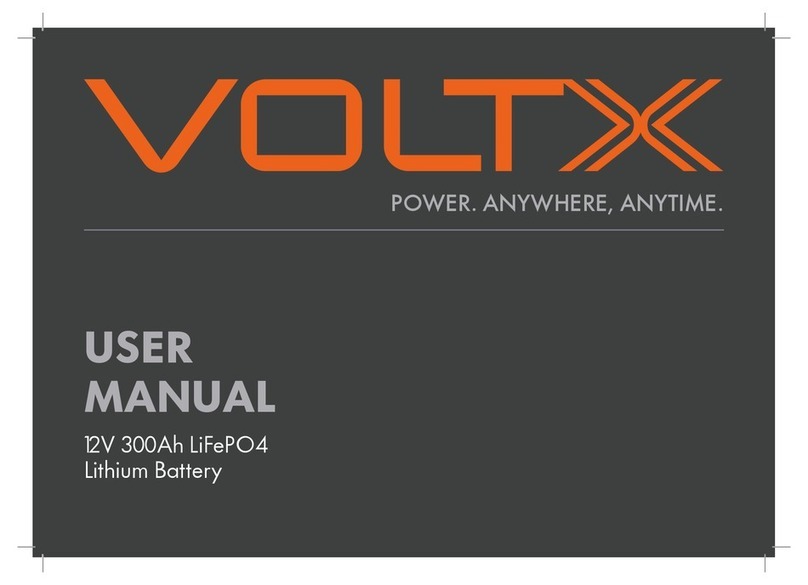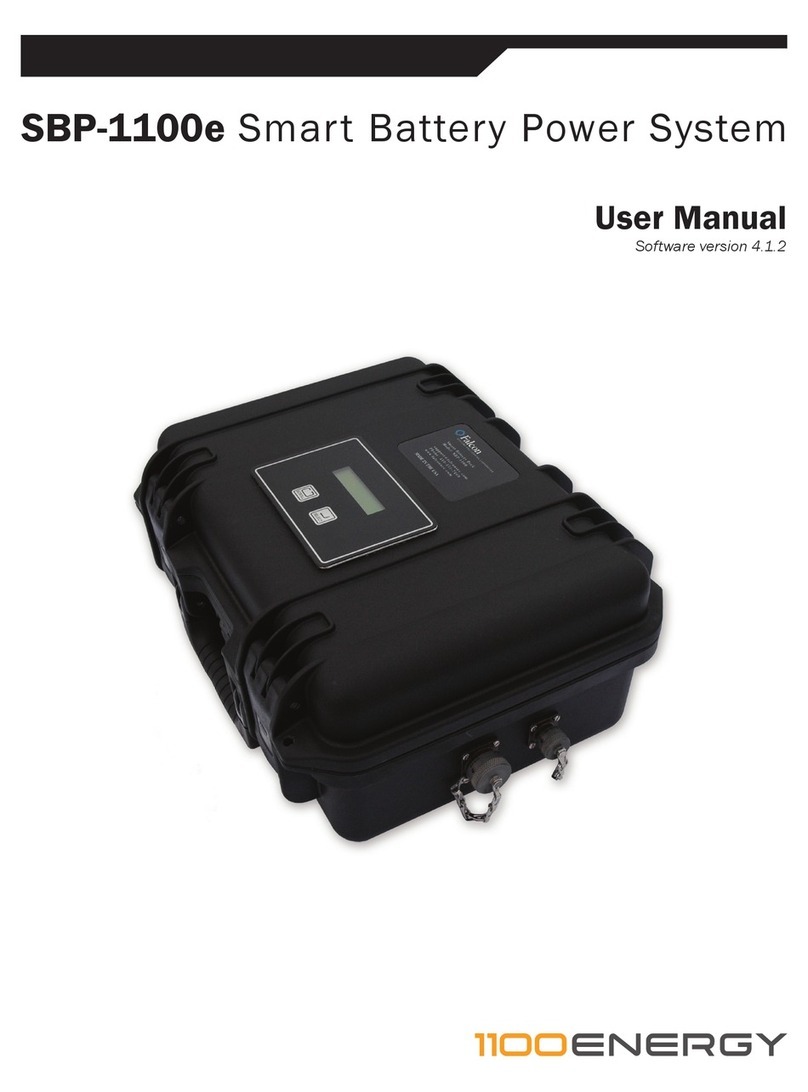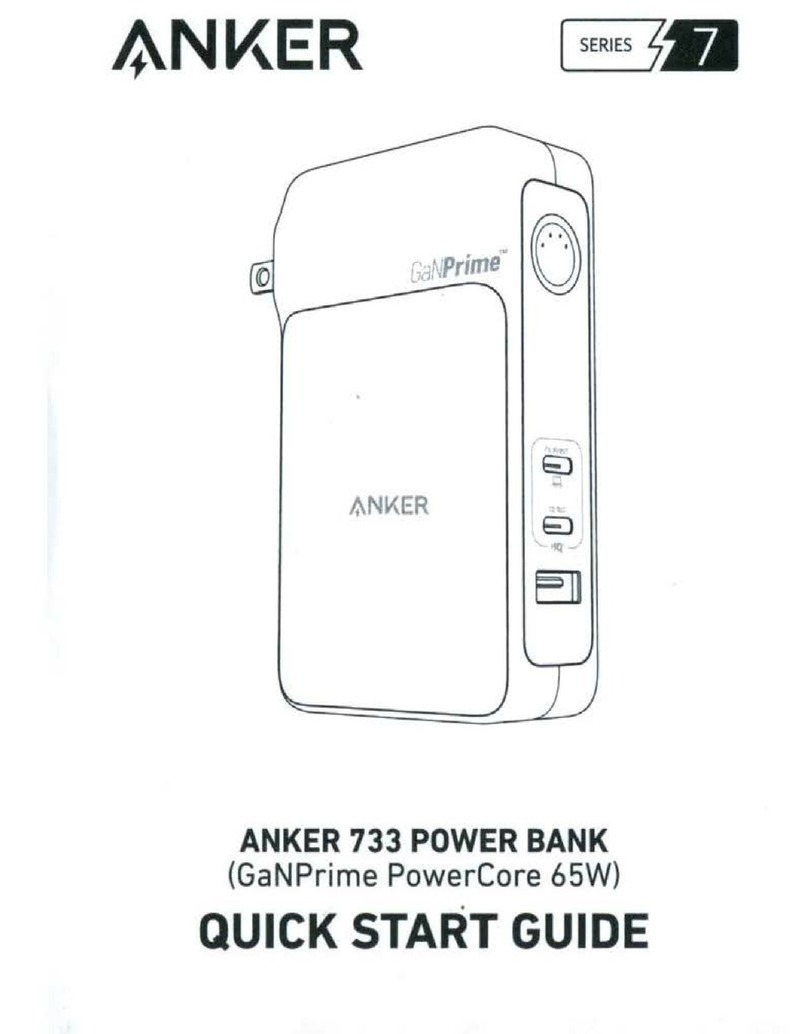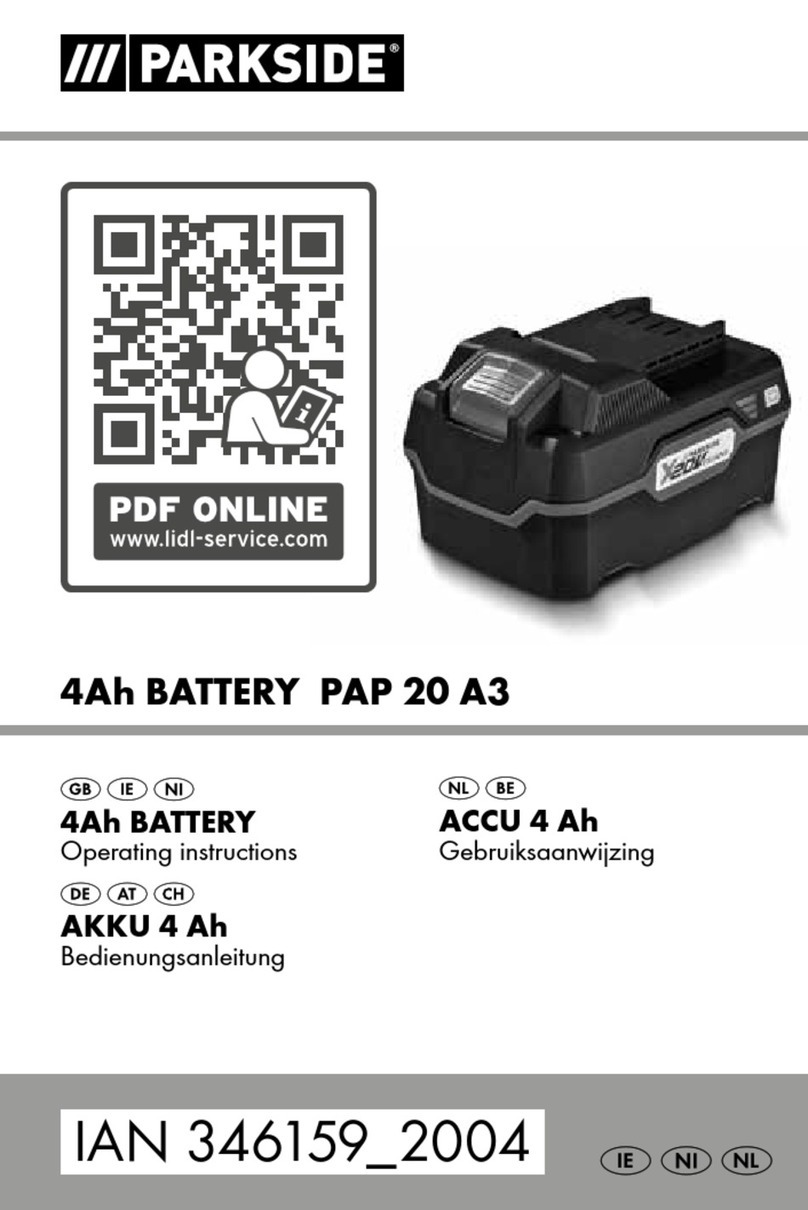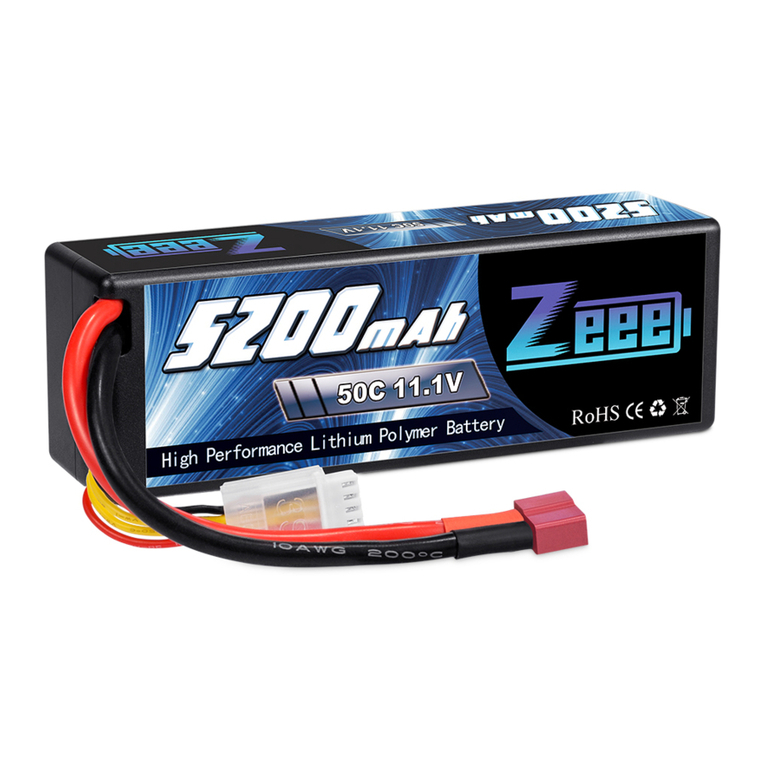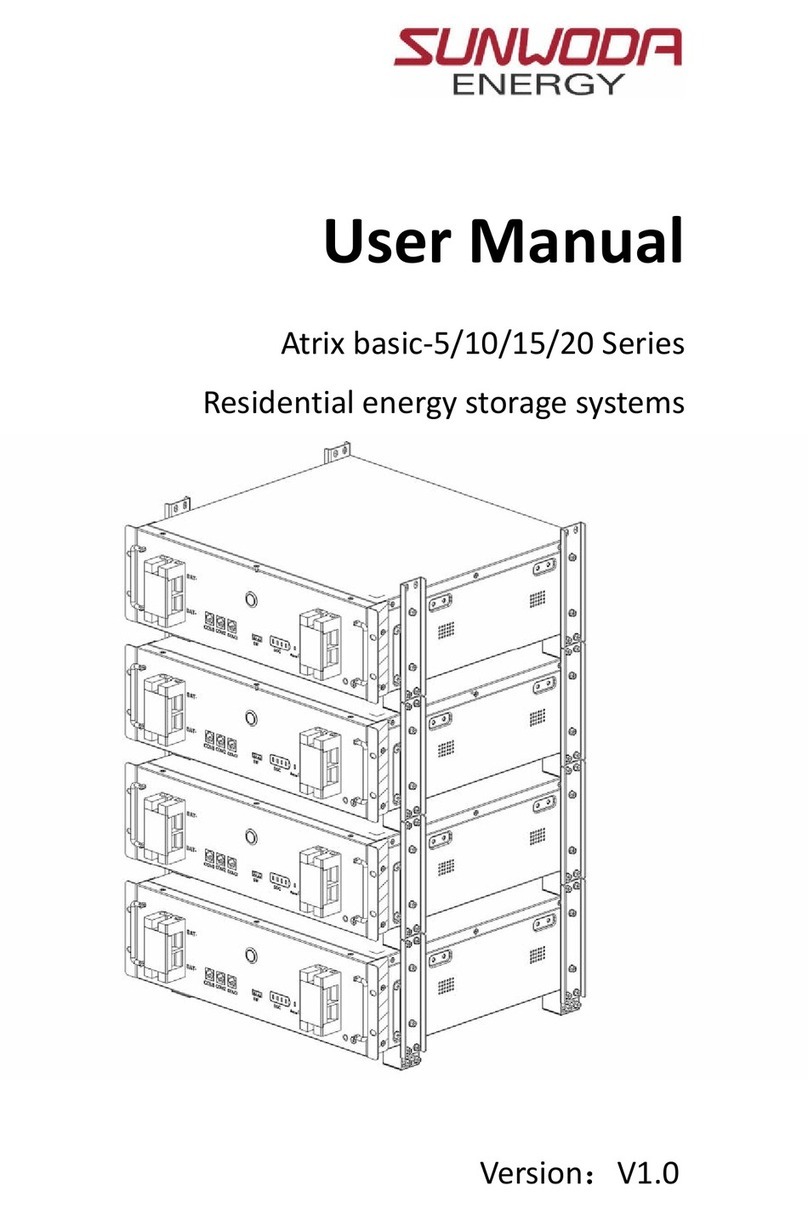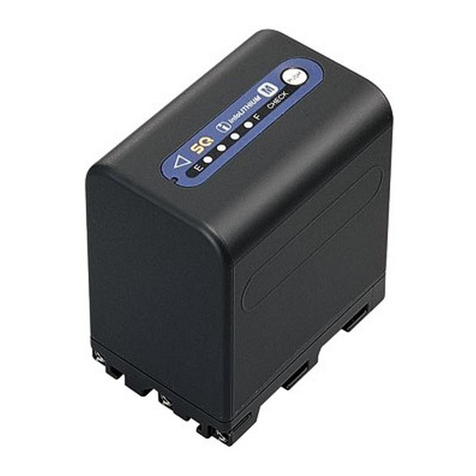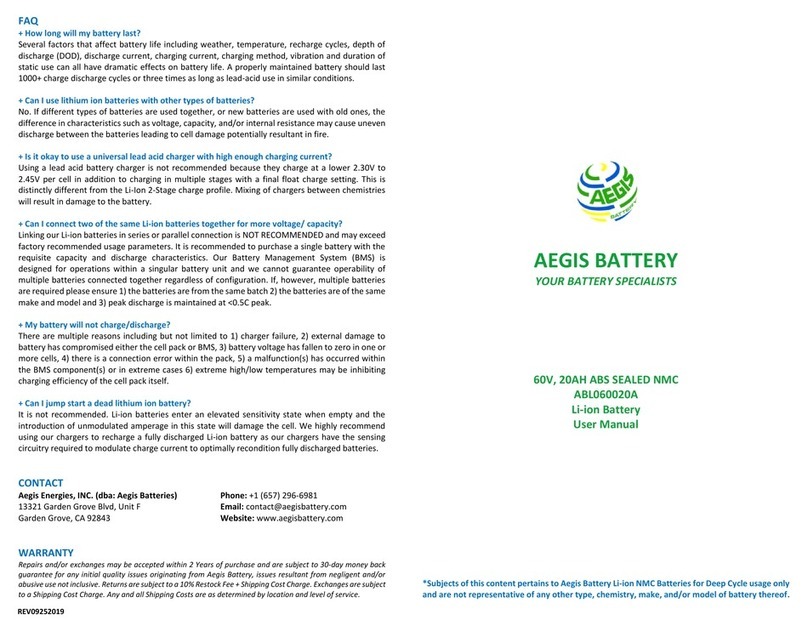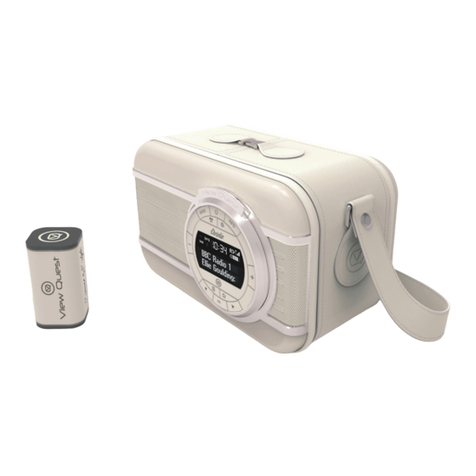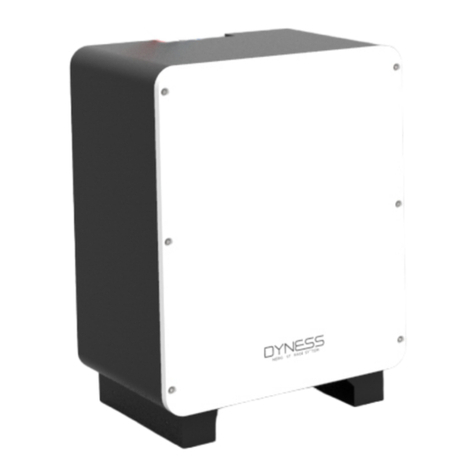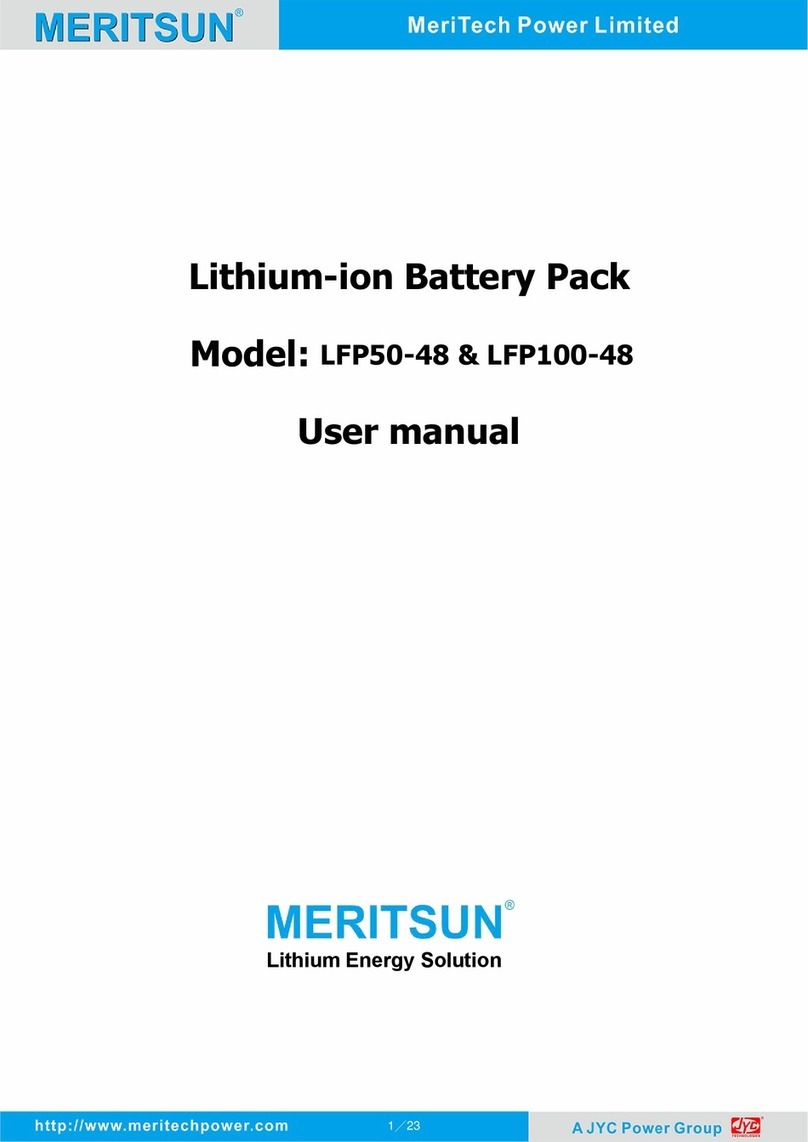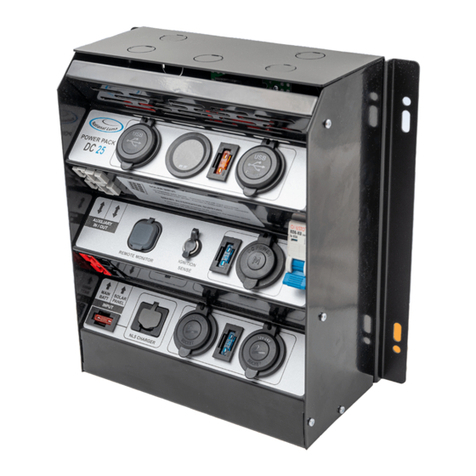Electus Distribution POWERTECH Lithium SB2220 User manual

Instruction Manual
12.8V 100Ah
SB2220
Lithium Slimline Deep-Cycle Battery
with Metal Case

1
Contents
Warning 2
1. Product Index 3
1.1 Product Parameter 3
1.2 Product Parameter Graph 3
1.3 Battery Management System 4
1.4 Battery Part Identication 5
2. Battery Usages 6
2.1 Charge 6
2.2 Discharge 6
3. Battery Service Environment 6
4. Special Attention 7
5.Battery Use and Maintenance 9
5.1 Battery Storage 9
5.2 Battery Check Before Use 9
5.3 Battery Installation 9
5.4 Battery Operating Requirements 10
5.5 Battery Operation 10
5.6 Battery Troubleshooting 11
6. Products Disclaimer 12

2
WARNING:
Quality Statement
Proper use and maintenance will ensure that the battery (or battery system) will
operate reliably and consistently for a long period of time.
• After receiving the product, please check if the packaging is in good condition.
If the packaging is broken, there may be damage to the product.
If there is damage, please contact your retailer or installer.
• Anyone who does not use or maintain the battery according to this owner’s
manual, gives up any right to warranty.
This battery is to be installed and serviced only by qualied personnel equipped
with appropriate personal protective equipment and following safe electrical
work practices.
Always wear eye protection, gloves, apron and mask when working with
batteries. Also remove any metal / conductive jewelry. Refer to the materials
safety data sheet (MSDS) for additional information including: hazards,
identications, electrolyte rst aid measures and precautions for safe handling
and use.
Precautions When Working With Batteries
• Consider your access to emergency medical attention, and work safely.
• Use caution to eliminate the risk of dropping a metal tool on the battery.
It could spark or short circuit the battery or other electrical parts and could cause
an explosion.
• Insulated tools are strongly recommended anytime you are working around
batteries.
• Never smoke or allow a spark or ame near the batteries.
• Remove all metal items, such as necklaces, rings, bracelets, and watches when
working with batteries. Batteries can produce a short circuit current high enough
to weld metal to skin, causing a severe burn.
• Ensure that someone is within range of your voice or close enough to come to
your aid when you are working near a battery.
• Wear complete eye / face protection and gloves. Avoid touching your eyes while
working near batteries.
• Never use or combine this battery with another dissimilar battery.
• Batteries are temperature sensitive. For optimum performance, they should be
installed in a stable temperature environment.
• Always recycle old batteries. Contact your local recycling center for proper
disposal information.
• Never wire the battery in series.

3
1. PRODUCT INDEX:
1.1 Product Parameter
Items Lithium Slimline Deep Cycle Battery with
Metal Case
Product Manual SB2220
Normal Voltage 12V
Nominal Capacity 100Ah
Energy 1200Wh
Internal Resistance ≤220mΩ
Size 190mm x 140mm x 230mm
Weight 11Kg
End of Charge Voltage 14.6V
End of Charge Current 100mA
End of Discharge Voltage 9.2V
Change Method 0.2C (0.5A) CC/CV
Max. Continuous Charge Current 50A
Nominal Discharge Current 100A (safe)
Max. Pulse Discharge Current 150A/10S
Operating Temp. Charge 0 ~ 45°C
Discharge -10 ~ 55℃
Storage Temp. -10 ~ 45℃ (60-80% SOC Storage)
Capacity @ 1C rate 0.2C ≥100Ah
Inverter Disconnect High 15V
Inverter Disconnect Low 12.5V
1.2 Product Parameter Graph
100
95
90
85
80
75
0 1000
E-4S1P/12V100Ah DOD-Cycles 0.2C,25
2000 3000 4000 5000 6000 7000 8000
Number of Cycles
Capa city(%)
100%
80%
50%
Capacity (Ah)
10- 0
Voltage(V)
9.5
10
10.5
11
11.5
12
12.5
13
13.5
14
10 20 30 40 50 60 70 80 90 100 110
14.5
Discharge
Charge
E-4S1P/12V100Ah Charge-Discharge Curve 0.2C,25

4
1. PRODUCT INDEX:
1.3 Battery Management System
Our lithium iron phosphate (LiFePO4) battery pack includes an onboard digital battery
management system (BMS). The BMS monitors voltage, current and temperature on
both an individual cell and battery pack level. If any of these measurements deviate
outside of their safe operating ranges, the BMS will actively work to correct the
deviation. If the deviation cannot be corrected automatically, the BMS will initiate a
self-protect shutdown by opening the internal contactor, disconnecting the battery
from the charger and loads.
Overcurrent protection – If the charge or discharge current of the battery exceeds
maximum permissible levels, the BMS will disconnect itself automatically. To recover
from a high current shutdown, remove the load from the battery, and then rest the
battery by turning the battery OFF and back ON.
Overcharge protection – If the battery`s voltage exceeds permissible levels the BMS
will disconnect itself automatically. To recover from a high voltage shutdown, remove
the charge source from the battery. The battery will automatically reconnect once the
charge source has been removed and the battery’s voltage drops down to permissible
levels.
Over discharge protection – If the battery`s voltage drops below permissible levels
the BMS will disconnect itself automatically. To recover from a low voltage shutdown,
remove the load from the battery. At this point the battery should be charged
immediately. If the battery does not start on its’ own, you may need to put a charger
on the battery. If the battery is so discharged that the Low Voltage Shutdown cannot
be cleared, the battery must be returned for non-warranty service.
Short circuit protection – If the battery suers from a short circuit, the BMS will
automatically disconnect. The battery will resume normal operation after the short
circuit is removed.
Temperature protection – If the battery`s temperature exceeds permissible levels the
BMS will disconnect itself automatically. The battery will automatically reconnect once
the temperature has returned to permissible levels.
Safety shutdown features on your inverter(s) and charger(s) should be the
rst line of protection against overcurrent or over voltage situations. Set your
system’s max current, high battery cuto (HBCO) and low battery cuto (LBCO)
according to the Charge / Discharge Parameters section of this manual. The
Battery Management System`s Shutdown is designed as a last resort self-
protect shutdown, and should not be relied upon for managing charge voltage
or currents. Doing so will signicantly shorten the battery’s life expectancy and
could negatively impact your inverter(s) or charger(s).

5
1. PRODUCT INDEX:
1.4 Battery Part Identication
Carry Handle
Display
Charge - 14.6V (50A MAX)
Discharge - 14.6V
(50A MAX)
Discharge - 14.6V
(120A MAX)
Remaining Battery
Switch (test battery status)
Battery Capacity / Voltage

6
2. BATTERY USAGE:
3. BATTERY SERVICE ENVIRONMENT:
2.1 Charge
Charging voltage is14.4 ± 0.15V. Do not reverse polarity.
2.2 Discharge
Make sure loads are properly wired to the positive and negative connections as
indicated on the battery case.
Battery discharge ambient temperature is -10°C~ + 55°C (When the ambient
temperature >45°C, please pay attention to the ventilation and heat dissipation).
Charging temperature is 0°C ~ + 45 °C. Ambient humidity RH is ≤85% . Pay attention to
eliminate moisture when the ambient humidity is >85%. Condensation on the surface
of the battery should be avoided.

7
4. SPECIAL ATTENTION:
In order to make full use of the energy eciency of the battery and prevent accidents
such as leakage or heat generation, please prohibit the following:
• Do not immerse the battery in water. If the battery is immersed in water do not
approach. Contact qualied personnel to remove the battery and dispose of it
safely.
• Do not charge, discharge or leave the battery at temperatures over 60°C. Keep
away from re, hot temperatures or corrosive substances. Failure to do so can
cause battery overheating. Battery overheating can lead to res and potential
danger and/or injury.
• Do not charge the battery at temperatures below 0°C.
• Do not wire the battery in series under any circumstances. Contact your supplier
or qualied battery installer before wiring in parallel.
• Do not reverse polarity when attaching to a charger. Never attach the battery
directly to any electrical outlet.
• Do not transport or store the battery together with metal objects such as
hairpins, necklaces, etc.
• Do not strike, trample, impact, drop or shock the battery.
• Do not directly weld the battery connections. Do not pierce the battery with a nail
or other sharp objects.
• Do not use the battery in any location where static electricity and magnetic eld is
strong. Doing so may be damage the battery protection circuit.
• Do not overload the battery.
• Do not alter the circuit board. This could damage the internal circuits and cause
battery failure.
• Do not deform or damage the outside of the battery case. Damage to the case
may cause electrical component failures and lead to battery instability.
• Do not open or remove the case.
• Do not overcharge or over discharge the battery.
• Please only use chargers designed to work properly with this battery.
• Please charge the battery within 12 hours of a complete discharge. If the battery
is not charged within 12 hours of a complete discharge, please test the battery
voltage before charging. If the voltage of the battery is < 8.0V, do not attempt to
charge the battery. Remove all wires and isolate the battery. Contact your installer
or battery distributor or service person.
• If the battery leaks and uid splashes into the eyes or on skin, do not rub the
uid. Wash o uid with clean water, and immediately seek medical attention.
• In case of accidental re, dry powder re extinguisher or sand should be used.

8
4. SPECIAL ATTENTION:
• If the battery gives o a strange odor, generates heat, becomes discolored or
deformed, or any abnormality appears during use, storage, or charging, stop
the battery from charging and stop use of the battery immediately. Remove and
isolate the battery from loads and charging sources and contact your battery
supplier or distributor.
• The terminals of any discarded battery should be covered to reduce any potential
safety hazard.
• Reversing the positive and negative terminals during charging will damage the
circuit board. Do NOT reverse polarity.

9
5.BATTERY USE AND MAINTENANCE
5.1 Battery Storage
Storage temperature 0°C~40°C (Optimum storage temperature 15°C~25°C, low
humidity). Battery performance is aected by temperature. Especially the change
in battery capacity. This is a normal phenomenon. Avoid condensation caused by
temperature changes during storage. Failure to do so can lead to corrosion, rust and
internal battery failure.
5.2 Battery Check Before Use
• After receiving the battery, rst check the packaging carefully. Make sure there
has been no damage to the battery during shipment.
• Please check the battery exterior for any damage or leakage. If there is any
damage or leaking, please contact your installer or distributor immediately.
• Make sure the battery voltage is within a normal range. Poor performance may
occur due to poor wiring connections to the charger or the loads.
5.3 Battery Installation
• Please install the battery to ensure minimal dust, metal or other foreign
materials. No smoking or re during installation. Avoid a short-circuit of the
battery to prevent equipment damage or personal injury.
• The battery should be installed in a well-ventilated space with no direct sunlight.
• Do not install where it could be submerged in water. The use and storage of the
battery should be kept away from any ammable and explosive materials.
• After installation, clean the surface of battery with dry cloth. Please don’t use oil
or other volatile organic solvents to clean or it may damage the case.
• Please make sure that the positive (+) & negative (-) polarity is correctly
connected. Failure to wire correctly may cause a re or damage the battery and
electrical appliances.
• After installation, test the battery and equipment. Observe whether the
equipment and battery are working correctly.

10
5.BATTERY USE AND MAINTENANCE
5.4 Battery Operating Requirements
• The charge and discharge current of the battery shall not exceed the specied
maximum charge and discharge current. Current input or output beyond
recommended levels may aect the lifespan of the battery, damage the internal
circuitry, or even cause a dangerous situation.
• When the battery is in a low state of charge, it should be charged quickly. This
helps prolong battery life. If the battery is not charged quickly from an extremely
low state of charge, battery life will be aected.
• LIFEPO4 batteries prefer a shallow discharge and charge cycle. For longest life, a
discharge of 20%, leaving 80% of the nominal capacity is recommended.
5.5 Battery Operation
• It is possible to over-discharge the battery if the battery is not used for long time.
In order to prevent over-discharging, the battery shall be charged every 2 months
to maintain a certain voltage range of13.32V~13.6V . For best life, a SOC/ capacity
calibration shall be performed. This calibration method charges the battery fully,
then discharges slightly to prevent an a possible over-discharged state. Letting
a battery sit for months without this procedure can lead to battery problems.
Contact your installer or distributor for more information about this procedure.
• Don’t use organic solvents to clean the battery case.
• A battery is a consumable product with limited cycle life. Please replace it before
the diminished capacity can’t meet the needs of the end user.
• In order to prevent failure of the overcharge protection board, do not charge
for overly long periods of time. After the battery is fully charged, remove it from
the charger. Only use acceptable battery chargers and operate the chargers
according to proper voltages for recommended amounts of time. Failure to do so
can damage the battery and possibly cause a potentially dangerous situation.
• A shallow charge and discharge of the battery ensures that the battery can
be used optimally. Overcharge and over discharge may cause the battery to
overheat, re or failure, shorten life, or other possible dangerous situations.
• Battery switches, displays and USB ports are not considered warranty items. The
battery can function ne without these items.
• Waste lithium batteries should be recycled and disposed in accordance with local
laws.

11
5.BATTERY USE AND MAINTENANCE
5.6 Battery Troubleshooting
• Battery voltage is too low after being fully charged.
Solution: Contact your installer or distributor.
• Battery is in long-term storage with no use and is not being maintained properly.
Solution: Please test the battery voltage. If the battery voltage is <8.0V, it can’t be
charged and needs to be un-wired and isolated. Please consult your installer or
distributor. If the voltage is ≥8.0V, the battery can be isolated to its’ own charger
and checked to see if it can be charged normally.
• Battery Disconnection.
Solution: Battery is powered but no voltage is present. Contact your installer or
distributor.
• Battery has suered a collision and has damage to the case or has an electrolyte odor.
Solution: It’s not in the end user to repair a damaged battery. Contact your
installer or distributor.
• Insucient capacity.
Solution: Charge fully and discharge to 50% SOC the battery with 3~5 cycles.
• Battery voltage is not stable or the battery cannot charge or discharge normally.
Solution: Contact your installer or distributor.
• Connectors or terminals not making good contact.
Solution: Clean or replace the connectors.
• Any other problems not described in this manual.
Solution: Contact your installer or distributor.

12
6.PRODUCTS DISCLAIMER
Before using the battery, please read the specications, usage/ maintenance
instructions and pay careful attention. Suppliers are not responsible for any incident
caused by not installing and operating the battery according to this manual. Any
problems from incorrect use, installation, connection, or input/output power,
inconsistent with this manual, may cause damage to product. Improper use or
installation can lead to battery damage and possible damage to the structure the
battery is housed and cause injury.
The manufacturer and distributors are not responsible for incorrectly installed or
used batteries. The manufacturer or distributors are not responsible for damage
to equipment from improper use or installation of these batteries.

13

14

Distributed by:
Electus Distribution Pty. Ltd.
320 Victoria Rd, Rydalmere
NSW 2116 Australia
www.electusdistribution.com.au
Made in China
Table of contents
